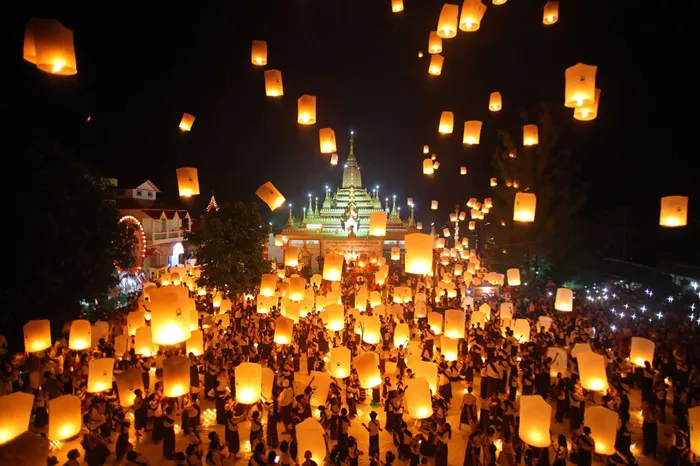Buddhist festivals are an important part of Buddhist culture, which not only commemorate the key events in the life of the Buddha and bodhisattvas, but also reflect the core values of Buddhism such as compassion, wisdom, and mindfulness. These festivals are celebrated in different ways in various regions, but they all aim to purify the mind, accumulate merit, and strengthen the connection between the Buddhist community.
Major Buddhist Festivals
Vesak (Buddha Day)
Vesak, also known as Buddha Purnima or Visakha Bucha, is the most important Buddhist festival, celebrated on the full moon day in May (or June in leap years). It commemorates the birth, enlightenment, and death of Gautama Buddha. On this day, Buddhists around the world visit temples, offer flowers, candles, and incense, and participate in meditation and chanting. In some countries, such as Sri Lanka and Thailand, people also release lanterns and perform cultural shows. Vesak was recognized by the United Nations in 1999 as an international day to acknowledge the contribution of Buddhism to world peace and spirituality.
Losar (Tibetan New Year)
Losar is the Tibetan New Year, celebrated in Tibet, Bhutan, and parts of India and Nepal. It usually falls in January or February according to the lunar calendar. Losar is a time for family reunions, cleaning houses, and making offerings to deities and ancestors. People wear traditional costumes, exchange greetings, and enjoy special foods such as momos (dumplings) and khapse (fried pastries). Monasteries hold elaborate rituals and mask dances to驱邪迎祥. In Bhutan, Losar is also marked by archery contests and horse races.
Obon Festival
Obon is a Japanese Buddhist festival held in July or August to honor the spirits of deceased ancestors. It is believed that during Obon, the spirits return to the world of the living. Families clean graves, offer food and flowers, and light lanterns to guide the spirits. The highlight of Obon is the Bon Odori dance, a traditional folk dance performed in temples and streets. On the last day, people release lanterns into rivers or the sky to send the spirits back to the afterlife. Obon is also celebrated in other countries such as China and Korea under different names.
Other Important Buddhist Festivals
Magha Puja (Sangha Day)
Magha Puja is celebrated on the full moon day in February or March to commemorate the Buddha’s first sermon to 1,250 enlightened disciples. It is also known as “Sangha Day” because it emphasizes the importance of the Buddhist community. On this day, Buddhists visit temples, listen to sermons, and make offerings to monks. In Thailand, Magha Puja is a public holiday, and people participate in candlelit processions around temples.
Asalha Puja (Dharma Day)
Asalha Puja falls on the full moon day in July, marking the Buddha’s first teaching of the Four Noble Truths and the Eightfold Path. It is also known as “Dharma Day” because it celebrates the beginning of the Buddha’s teachings. Buddhists observe this day by meditating, listening to dharma talks, and making donations to temples. In Thailand, Asalha Puja is followed by the start of the Buddhist Lent, a three-month period of retreat for monks.
Kathina Ceremony
The Kathina Ceremony is held after the Buddhist Lent in October or November. It is a time when laypeople offer new robes and other necessities to monks. The ceremony symbolizes the gratitude and support of the lay community for the monastic order. In Thailand, the Kathina Ceremony is a grand event, with monks parading through the streets and receiving offerings from devotees.
Uposatha Days
Uposatha Days are observed on the full moon, new moon, and quarter moon days of each lunar month. They are days of spiritual renewal and reflection for Buddhists. On these days, laypeople often visit temples, observe the eight precepts, and participate in meditation and chanting. Monks also gather to recite the Patimokkha, the monastic code of conduct.
Regional Variations and Practices
Thailand
Thailand is a predominantly Buddhist country, and its festivals are rich in tradition. In addition to Vesak and Magha Puja, Thailand also celebrates Loy Krathong, a festival of lights held in November. During Loy Krathong, people float decorated baskets (krathongs) on rivers to pay respect to the water spirits and seek forgiveness for polluting the environment.
Japan
Japan’s Buddhist festivals include Obon and Bodhi Day. Bodhi Day, celebrated on December 8, commemorates the Buddha’s enlightenment under the Bodhi tree. On this day, Japanese Buddhists meditate and offer thanks for the Buddha’s teachings. Some also eat a special meal of rice and milk, which is said to be what the Buddha ate after attaining enlightenment.
Cambodia
Cambodia’s Pchum Ben Festival is a 15-day event in September or October to honor ancestors. During this time, families visit pagodas, offer food and prayers, and make “bai ben” (rice balls) for the spirits of the deceased. The 15th day, known as “Ben Thom,” is the most important day, when people dress in white and participate in elaborate ceremonies.
Conclusion
Buddhist festivals are not only religious events but also cultural celebrations that bring communities together. They provide an opportunity for Buddhists to reflect on the teachings of the Buddha, practice compassion and generosity, and strengthen their spiritual bonds. Whether it is Vesak, Losar, Obon, or other festivals, each has its unique significance and traditions, but they all share the common goal of promoting peace, wisdom, and harmony in the world.

